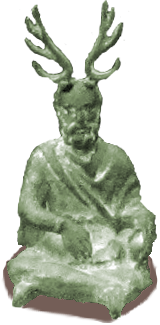
Bronze statuette of Cernunnos. The bearded and antlered god sits cross-legged, his expression benevolent.
(Römisch-Germanisches Zentralmuseum, Mainz)

Images · Texts · Antlered Goddesses · Ram-Headed Snake · Dis Pater
Cernunnos is, on two counts, the most iconic god of Celtic religion. Firstly, because his depictions are found across a wide area with highly recognizable characteristics (this is in fact the best evidence, such as it is, for a Celtic religion in the singular). And secondly, because practically all that we know of this god is iconographic in nature. The most remarkable trait of Cernunnos is his antlered head (or, much less often, horned). He is almost always sitting down, and in fact sitting in a cross-legged posture that we rarely find other Gaulish gods in. Around his neck is typically a torc, and in his hand a cornucopia or a purse. He is frequently surrounded by a wide array of animals. The god’s image perfectly epitomizes the richness that is to be found in untamed Nature.
The reader is encouraged to visit the webpage of Ceisiwr Serith, who gives a fine and detailed presentation of the artifacts by which we come to know Cernunnos. This page summarizes that evidence, while adding the interpretation of the three relevant texts, a section on related goddesses, and other relevant matters.
The motif of an antlered god accompanied by a serpent is many centuries old. It is first found in the rock carvings of Val Camonica, in the Italian region of Lombardy, made by the Camunni, a people related to the Celts. Depictions of Cernunnos are particularly concentrated in Belgica Secunda, in the same areas as the three-headed god.[1a] They are more sparsely attested throughout the Gaulish/Celtic cultural zone—but practically absent from the British Isles.
Among the depictions of this god (of which there are about forty in all), the most striking are to be seen on the Gundestrup Cauldron, the Reims Altar and the Pillar of the Boatmen in Paris. It is this last that supplies us with the name Cernunnos, about which more presently. The first two introduce us to a rich and complex iconography, which undergoes interesting evolutions in other depictions as well.
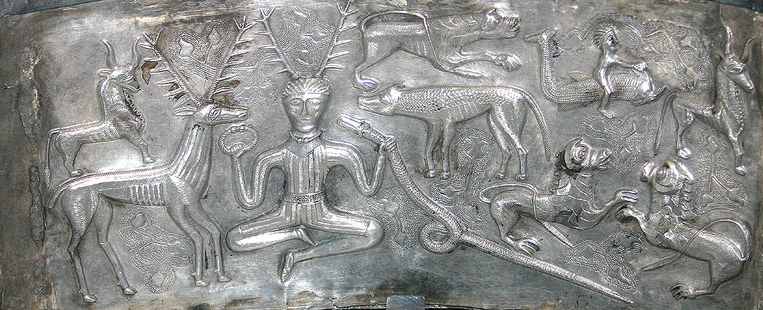
The Gundestrup Cauldron, while produced by Thracians and discovered in Denmark, nevertheless reflects the tastes and symbolism of the Celts who are thought to have ordered it. Panel A shows a seated god with one torc in his hand and another around his neck, the head topped with antlers; his other hand holds by the neck a ram-headed snake. This figure, which we immediately recognize as Cernunnos, is surrounded by animals: a stag, ibexes, lions, a dog, a doe and even a person riding a dolphin. This panel is one source for the frequent modern characterization of Cernunnos as ‘Lord of the Animals’.
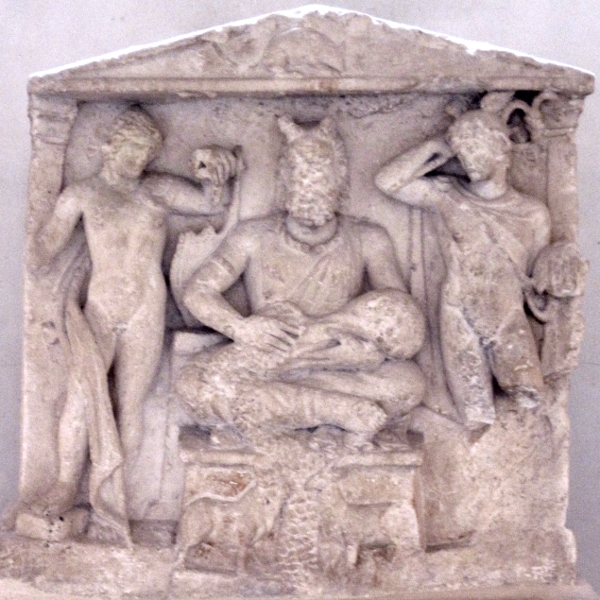
The Reims Altar is a high relief in the shape of a shrine that depicts three gods: Cernunnos in the centre, flanked by Mercury and Apollo. The latter, almost naked, has just given a strum to his lyre, while the former (wearing a traveller’s cloak and his winged helmet) stands by, holding his caduceus and money-bag. The antlered god (though part of the antlers are lost) sits on a dais, torcs on his neck and arm, pouring out grain from a great sack. Below him, a bull and a deer graze on the falling grains. In the tympanum may be seen a rat (an animal rarely found elsewhere in the religious iconography of Gaul; its placement at the top of the monument has been said to emphasize the subterranean location of Cernunnos’ abode[1b]). This is one of the clearest indications of Cernunnos’ role as provider of the riches of the Earth—all the more so if we identify the grains instead as coins, as a number of scholars do.[2]
It may be observed that Cernunnos, despite his link with wild Nature, is no hermit. Rather, he is surrounded by animal and divine companions. Here, one might almost say, is a Gaulish Pan: a god who is found in wild places among his flocks of animals, if not bands of nymphs and fauns....
The god most closely linked with Cernunnos is Mercury (and recall that Pan too is a son of Mercury). They are found together in a number of depictions; their roles as guarantors of prosperity were complementary in the eyes of the Gauls. This is still more the case in light of Mercury’s role as psychopomp (the guide of departed souls into the Otherworld) and Cernunnos as an underworld deity.... We shall return to this subject below.
Cernunnos’ essential iconography—antlers, cross-legged posture, prosperity symbols—can vary here and there. At Amiens, for example, a fine bronze statue represents a cross-legged god with the ear of a deer rather than its antler. As it happens, the ear of a god is an important votive symbol (given in order that the god might hear the prayer of the worshipper). Several statues have sockets at either side of the head where real antlers would be inserted (and removed seasonally?). There are also cross-legged gods with deer’s legs (such as that of Bouray).
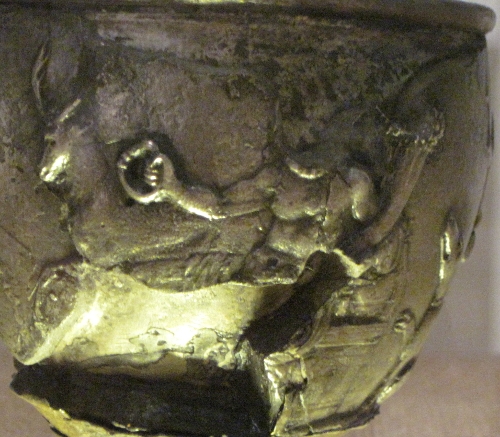
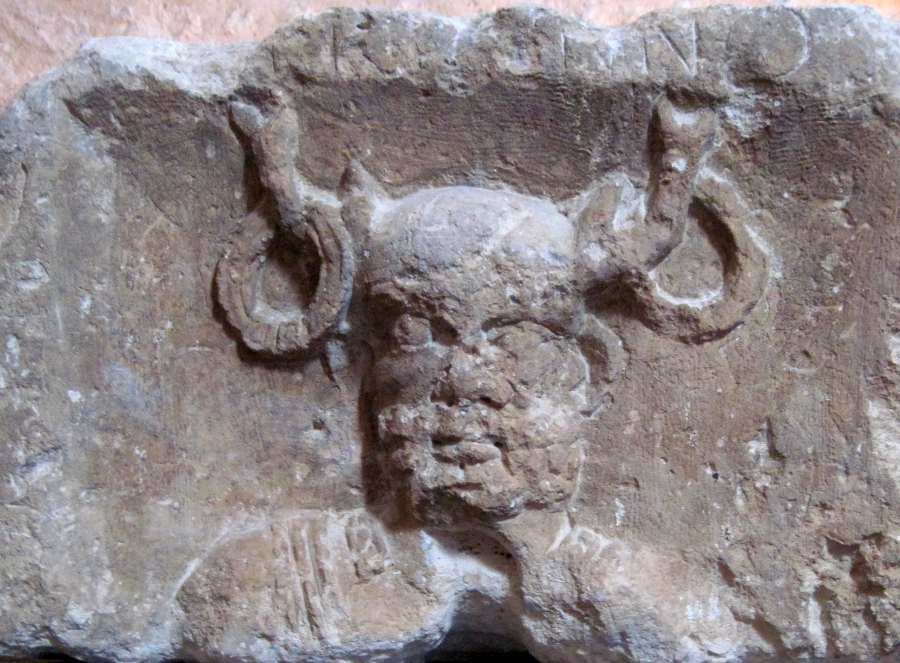
Thus far, only three texts relating to this god have been found. The earliest discovered is the simplest: no more than the name CERNVNNOS on the Pillar of the Boatmen (found beneath the Cathedral of Notre-Dame in Paris). The initial C has now disappeared, but old descriptions assure us that it was once visible. Thanks to the Pillar of the Boatmen, familiar to scholars for centuries, it is by this name that Cernunnos is known to the world.
The second text is a bit longer and all the more interesting for being written in Gaulish rather than Latin. Written in the Greek alphabet, it was found at Montagnac in the Hérault (southern France).
ΑΛΛΕΤ[ΕΙ]ΝΟС ΚΑΡΝΟΝΟΥ ΑΛ[Ι]СΟ[ΝΤ]ΕΑС
“Alletînos [son] of Alisontea, to Carnonos”[3]
The names Carnonos (which might just as well be transcribed as Karnonos) and Cernunnos differ on three linguistically important points: two vocalic alternations (a as opposed to e, and o as opposed to u) and the simplification of the double consonant (n as opposed to nn). These phonological difficulties are real. For now, however, both forms are widely accepted as variants of the same name. Note that Carnonos contains the same augmentative suffix -on- that is found so often in the names of other deities (Epona, Damona, Ðirona, Ritona, Divona, Maponos, Matronæ, etc.). The deformation of this familiar suffix into -unn- is thus all the more surprising. The image of Cernunnos on the Pillar of the Boatmen is ‘horned’ (that is to say antlered); the name Carnonos can be interpreted as “horned god”[4] (though I would say rather “great horn”), which strengthens the hypothesis of a unity of the names.
A third text should be mentioned, though its relevance to the Cernunnos we know is debatable.
DEO CERVNIN/CO SOLTRIVS/ PRVSCVS/ V(otum) S(oluit) L(ibens) M(erito)
“To the god Cerunincus, Soltrius Pruscus fulfilled his vow freely and willingly”[5]
This text was inscribed upon a bronze plaque in present-day Luxembourg. The bronze statuette of a beardless god who might be Cerunincus was also found. The names Cernunnos and Cerunincus resemble each other, but perhaps only by coincidence. Any relationship between Cerunincus and Carnonos is still more difficult to discern (and it is the form Carnonos that makes the most sense from a linguistic point of view).
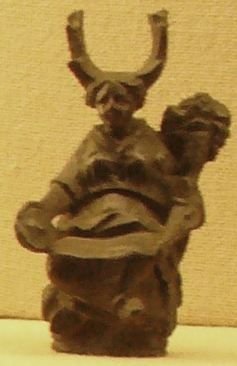
A number of small figurines reveal the cult of an antlered goddess. A few come from Clermont-Ferrand (the capital of the Arverni in the Massif Central) and others from Besançon and Broye (among the Sequani in what is now the department of Haute-Saône). The image at right illustrates the type. The goddesses most often hold an offering-dish and a cornucopia. These symbols of divine providence are equally associated with Rosmerta, as well as with the lares (the objects of daily household worship) and other gods and genii.
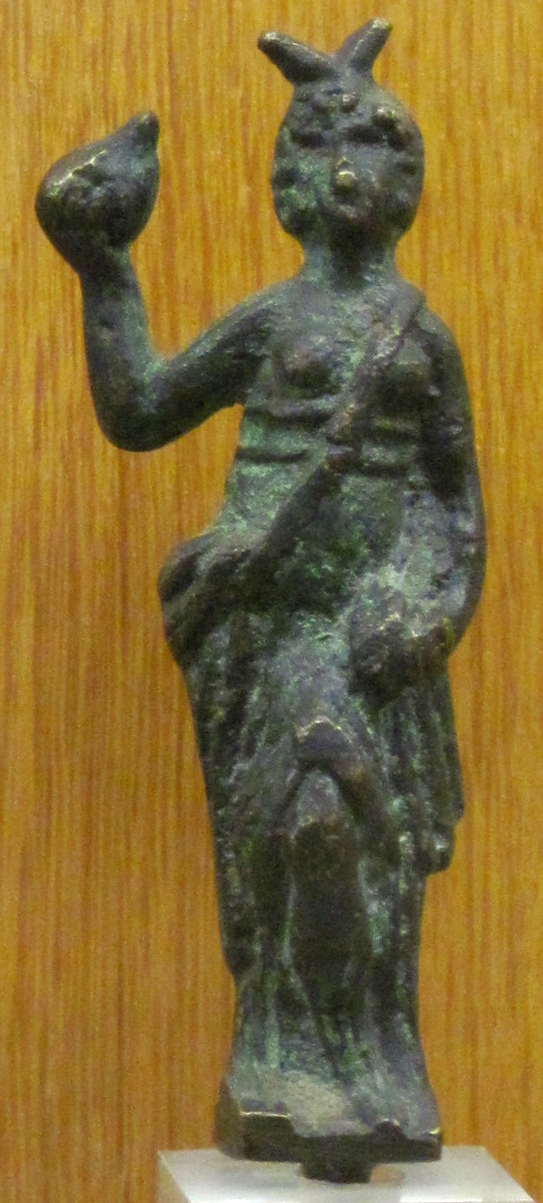
Might this goddess be a local female avatar of Cernunnos? or perhaps a distinct deity who shared his attributes? In the latter case, should we conceive of her as the wife, the daughter or the sister of Cernunnos? The evidence does not permit us to say.
At all events, it is rather remarkable to bestow upon clearly female goddesses such a quintessential feature of male animals. There is more than a hint here of androgyny. Divine androgyny, for its part, is a recurring theme in classical mythology (witness the warrior Minerva, the hunter Diana, Apollo with his feminine suppleness, Hermaphroditus son of Mercury and Venus, and so on).
The androgyny is frankly provocative in the rather crude sculpture illustrated at left. A bare-breasted goddess pulls back her skirt to show off her leg. Her supple posture (a distant derivative from Praxiteles?) and the bird attribute would have been more than enough to identify the goddess as Venus ... if she did not have a pair of bull’s horns on her head.
Still, not all horned deities (whether male or female) are necessarily to be associated with Cernunnos. Horns are a motif connoting power and bellicosity that are to be found among several gods ... as well as on the helmets of mortal warriors. The stock image of the Viking with a horned helmet is actually based upon Celtic helmet types.
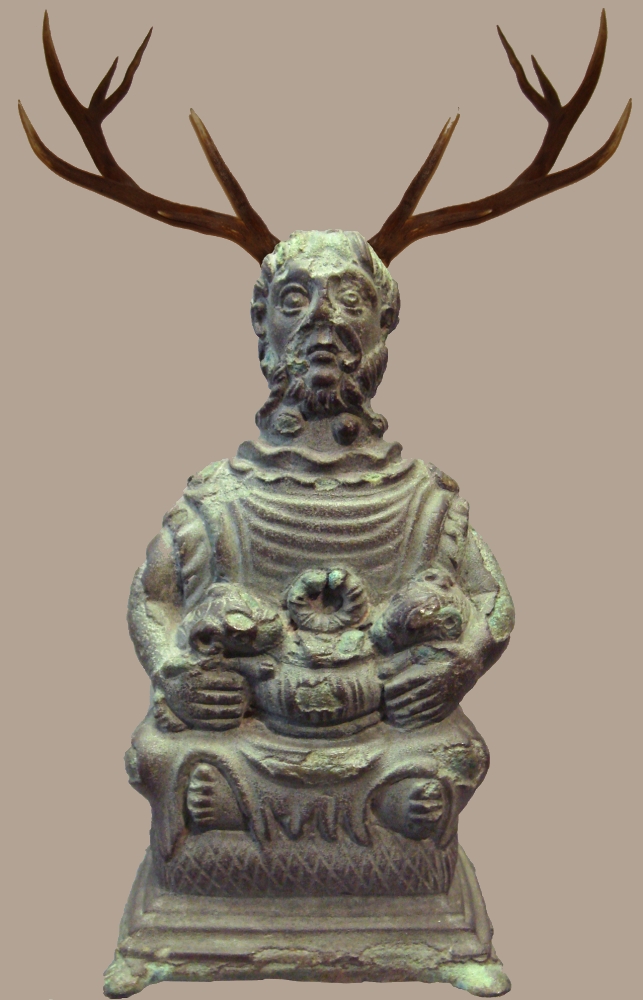
One of the animals that accompanies Cernunnos most often is a mythical creature typical of the Gaulish Celts, namely a serpent with the head of a horned ram. Several examples appear on the panels of the Gundestrup Cauldron. We have seen Cernunnos hold this snake by the neck; elsewhere, the two coexist harmoniously. At times Cernunnos even feeds the snake or, as in the image on the right, lets two such serpents lie in his lap like pets. (These creatures even appear to have the front hooves of sheep—a characteristic of the young of the ram-headed snake?)

This animal may be related to guardian genii, visualized as serpents in the Mediterranean tradition. The special feature of the snake is to remain in constant contact with the Earth; for that reason, it has become the chthonic symbol par excellence. The genii depicted are serpents are those of place, namely those most exactly earthly.
Ceisiwr Serith associates the ram-headed snake with the dragon hoarding riches (a familiar motif from Europe to India and China) and considers this a symbol of death, of the Otherworld, of disorder. Serith considers Cernunnos as the mediator between this chthonic disorder and the well-being of the living, just as he is the mediator between nature and culture.[1c] Thus, on the Gundestrup Cauldron, Cernunnos restrains the serpent in order to free up the wealth that he has accumulated. Cernunnos would thus be the key player in a constant conflict between prosperity and death (which is perhaps to be linked with the motif of the equestrian Jupiter triumphing over giants with serpentine legs). Personally, I prefer to see Cernunnos and the ram-headed snake as allies (after all, we sometimes see Cernunnos nourishing the serpent) whose role is at once chthonic and provident, in one and the same paradox. The god bestows on the living the wealth of the underworld, and in the end our souls shall return to him.
“All the Gauls claim to be descended from Dis Pater, and say that this tradition has been handed down by the Druids. For that reason they compute the divisions of every season, not by the number of days, but of nights [...].”
—Julius Cæsar (recapitulating Posidonius)[6]
The identity of the Dis Pater of whom Posidonius speaks (through Cæsar) has provoked lively debate. The main facts are these: Dis Pater (a Latin name for Pluto) is a god of the underworld—first and foremost of the mineral wealth that comes from within the Earth, but equally of Tartarus and of death itself. The fact that it was the druids who promulgated the tradition that that Gauls descended from Dis, is no doubt related to the high importance that druidic philosophy placed on the doctrine of the immortality of the soul.
Scholars have often suggested that Dis Pater is to be identified with Cernunnos.[7] The latter is characterized by a posture that places him in close connection with the Earth; his frequent companion is the ram-headed snake (with equally strong chthonic associations); on the Reims Altar, we see him distributing coins (if not grains), thus riches coming from the world below; the rat that establishes his subterranean abode has already been alluded to. One might also add a negative argument: What other god that had the importance of this Dis Pater has not already been identified differently? To be sure, the identification is not certain. Others have suggested Silvanus Sucellus as a candidate for Cæsar’s Dis Pater.
Still, the eventual disappearance of Cernunnos could also be explained if the importance of his cult depended on the teaching of the druids. The belief in their doctrines did not disappear at once, which is why people were still producing monuments like the Reims Altar during the time of Augustus. Nonetheless, depictions of Cernunnos gradually disappeared as Romanization took hold (and thus as druidic philosophy came to be definitively displaced). The same could hardly be said of Silvanus, whose cult flourished even as the memory of the druids waned.

